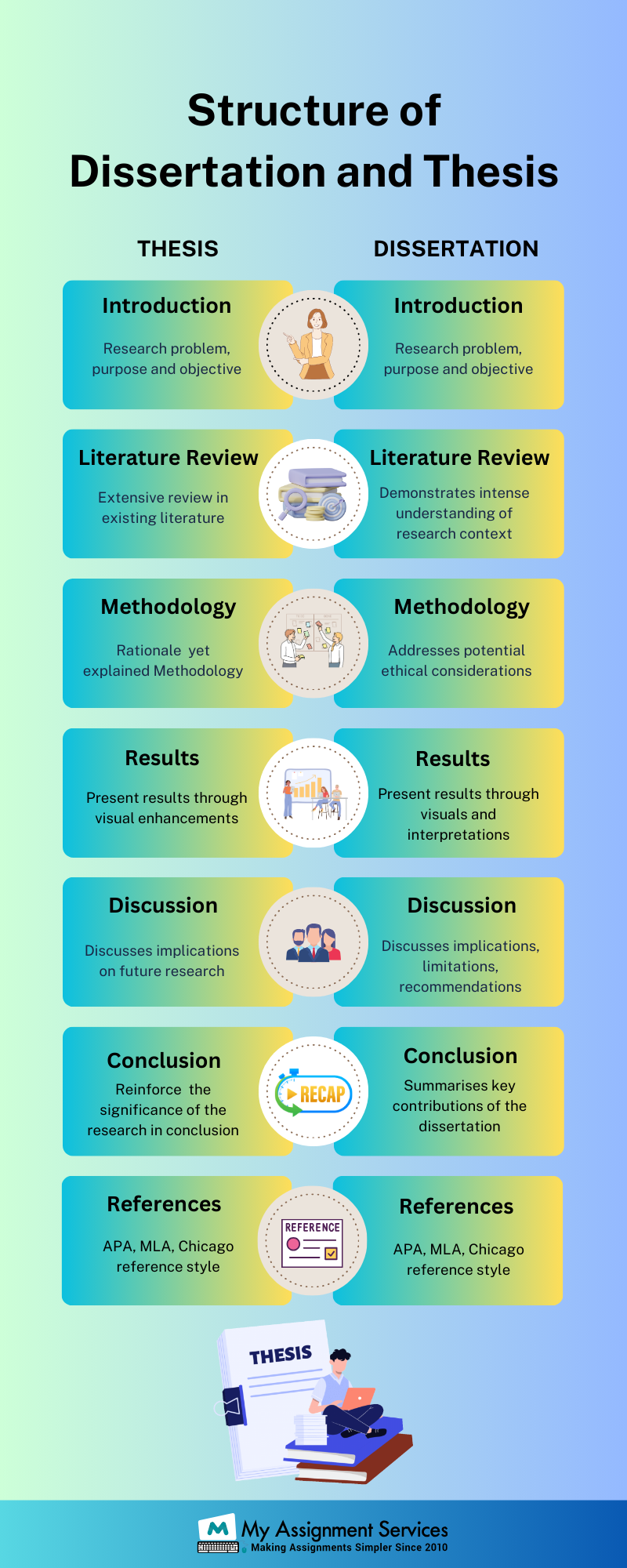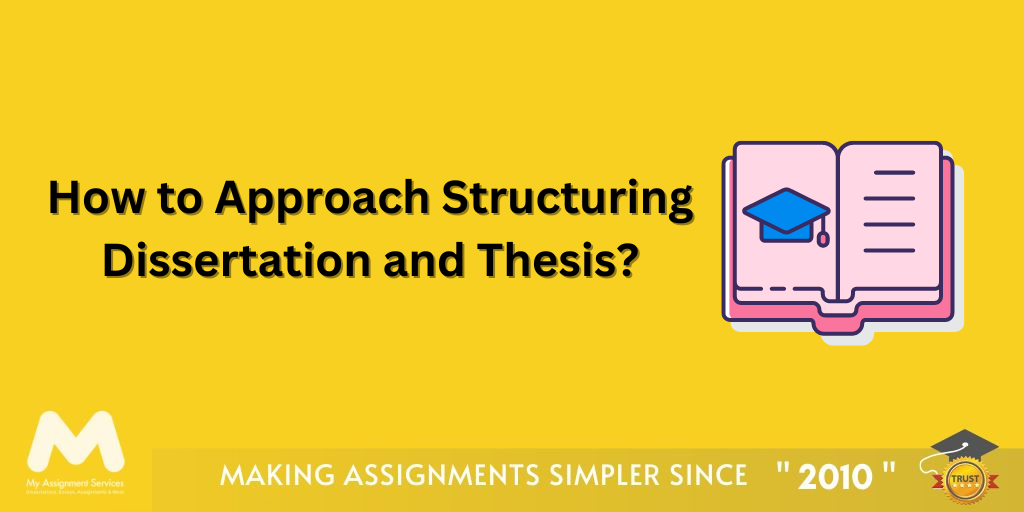Starting your dissertation or thesis is like stepping into a big, unknown academic world. Think of yourself as an explorer, creating new ideas that change how we understand things. Your dissertation or thesis structure is your chance to be a researcher and tell a really interesting academic story. It's not just another university assignment – it's like your best work, showing off all the effort you put in and how smart you are. As you read, research, and analyze, remember you are not just doing university work; you are creating something that sticks around in your field. Get ready for this big, brainy adventure – in this blog, you are not just learning but making the future of what we know.
What is Dissertation and Thesis?
A dissertation and a thesis are substantial pieces of scholarly writing, but they differ in scope, purpose, and the stage of academic pursuit in which they typically occur. In the academic curriculum, a thesis is commonly associated with a master's degree, while a dissertation is generally linked to a doctoral degree.
A thesis is a comprehensive research project undertaken at the master's level, culminating in a student's academic journey. It involves an in-depth exploration of a specific research question or topic, demonstrating the student's ability to conduct scholarly research and contribute to their academic field independently. Ultimately, the goal is to present a well-argued and evidence-supported thesis statement that adds to the existing body of knowledge in a particular subject.
On the other hand, a dissertation is a more extensive and rigorous research project undertaken during a doctoral program. It represents the pinnacle of a student's academic achievement and involves an original contribution to the field of study. A dissertation structure demands more independent research, critical analysis, and theoretical engagement. It typically includes multiple chapters, including an introduction, literature review, methodology, findings, discussion, and conclusion.
Differences and Similarities Between Dissertation and Thesis
In this academic world, students often encounter the terms "dissertation" and "thesis," two distinct but interconnected pillars of scholarly research. Both projects signify students' ability to engage in independent inquiry and contribute to their academic field. However, nuances exist in terms of scope, purpose, and the academic level at which they are typically pursued:
|
Aspect
|
Dissertation
|
Thesis
|
|
Academic Level
|
Typically associated with doctoral programs. |
Commonly linked to master's degree programs. |
|
Scope
|
Involves an extensive and original research contribution, often shaping new areas of knowledge. |
Requires a comprehensive exploration of a specific research question, demonstrating mastery in a particular subject. |
|
Purpose
|
Aims at advancing the field with original insights and findings.
|
Seeks to showcase the student's ability to independently conduct research and contribute to existing knowledge. |
|
Length
|
Generally longer, with more extensive chapters and in-depth analysis. |
Shorter in comparison, with a focus on a concise yet thorough exploration of a particular topic. |
|
Structure
|
Follows a detailed structure, including multiple chapters such as introduction, literature review, methodology, findings, discussion, and conclusion. |
Thesis structure format comprises key sections like introduction, literature review, methodology, results, discussion, and conclusion. |
|
Originality
|
Dissertation structure demands a significant and unique contribution to the academic community. |
Requires originality but typically on a smaller scale, building upon existing knowledge rather than forging entirely new paths. |
|
Outcome
|
Culminates in the awarding of a doctoral degree. |
Represents the apex of a master's program, leading to the conferment of a master's degree. |
How to Structure Thesis and Dissertation?

When crafting a comprehensive academic document, a clear and well-organized structure is vital to communicate research findings effectively. That's why students seek urgent assignment help to ace their dissertation or thesis and score good marks. So, whether starting on a thesis or a dissertation, understanding the prescribed format serves as a foundational guide for researchers, enabling them to present their work in a manner that is both scholarly and accessible:
Thesis Format:
Introduction
- Statement of Research Question: Clearly articulates the main research question or thesis structure.
- Scope and Objectives: Outlines the specific scope and objectives of the study.
- Significance: Establishes the significance of the research within the context of existing literature.
Literature Review
- Survey and Analysis: Surveys and critically analyses relevant literature.
- Identification of Key Theories: Identifies key theories and concepts related to the research topic.
- Highlighting Gaps: Highlights gaps or controversies in existing research.
Methodology
- Research Design: Details the chosen research design, approach, and methods. That's why students get help from thesis writing help services to choose the right research design.
- Rationale for Methods: Explains the rationale behind the chosen research methods.
- Addressing Limitations: Addresses any limitations in the research design.
Results
- Presentation: Presents the research findings in a clear and organized manner.
- Visual Enhancements: Utilises tables, graphs, or charts to enhance data presentation.
- Avoiding Interpretation: Focuses solely on presenting results, deferring interpretation.
Discussion
- Interpretation: Interprets the results in the context of the research question.
- Relating to Literature: Relates findings to existing literature.
- Implications and Future Research: Discusses implications, limitations, and potential areas for future research.
Conclusion
- Summarisation: Summarises the key findings of the study.
- Reinforcing Significance: Reinforces the significance of the research.
- Future Exploration: May suggest avenues for further exploration.
References
- Comprehensive List: Lists all sources cited in the thesis structure.
- Citation Style Adherence: Follows a specific citation style (APA, MLA, Chicago, etc.).
Dissertation Format:
Introduction
- Research Problem Introduction: Introduces the research problem, purpose, and objectives.
- Significance Rationale: Provides a rationale for the dissertation's significance.
- Overview of Structure: This may include an overview of the dissertation's structure.
Literature Review
- Extensive Review: Conducts an extensive review of existing literature.
- Theoretical Framework: Establishes a theoretical framework for the study.
- Demonstrating Understanding: Demonstrates a deep understanding of the research context for dissertation structure.
Methodology
- Detailed Description: Describes the research design, methods, and procedures in detail.
- Rationale Explanation: Discusses the rationale for the chosen research methods.
- Ethical Considerations: Addresses potential ethical considerations.
Results
- Detailed Presentation: Presents detailed findings, often with extensive data analysis.
- Visual Clarity: Utilises visuals such as tables, figures, and graphs for clarity.
- Balancing Presentation and Interpretation: Maintains a balance between detailed presentation and interpretation.
Discussion
- Analysis and Interpretation: Analyses and interprets the results within the broader context.
- Relating to Literature and Framework: Relates findings to existing literature and theoretical framework with the help of dissertation help
- Implications and Recommendations: Discuss implications, limitations, and recommendations.
Conclusion
- Key Contributions Summary: Summarises the key contributions of the dissertation.
- Reflecting on Research Process: Reflects on the overall research process and outcomes.
- Future Research Proposals: Proposes avenues for future research.
References
- Comprehensive Citation: Provides a comprehensive list of all sources cited in the dissertation structure.
- Citation Style Adherence: Adheres to a specific citation style as per academic guidelines.
Explore the Potential of Your Academic Writing Journey with My Assignment Services!
In the world of academic research, think of your thesis or dissertation structure as a blueprint that puts your ideas together. Making your way through each part carefully ensures your work meets the highest standards and adds something valuable to what others already know. Whether focusing on a thesis, wher details are crucial, or diving into a dissertation, where you explore a lot, this roadmap guides you.
Also, as you work on your research, My Assignment Services are here for you. Our team knows the ins and outs of academic writing and is ready to help at every step. Hence, if you need a strong start or want to polish up your analysis, the urgent assignment help service is here to ensure your work looks great and reaches its full potential. So, let us be your partner in doing well in your studies. Your success is important to us; together, we can make your academic dreams come true!





